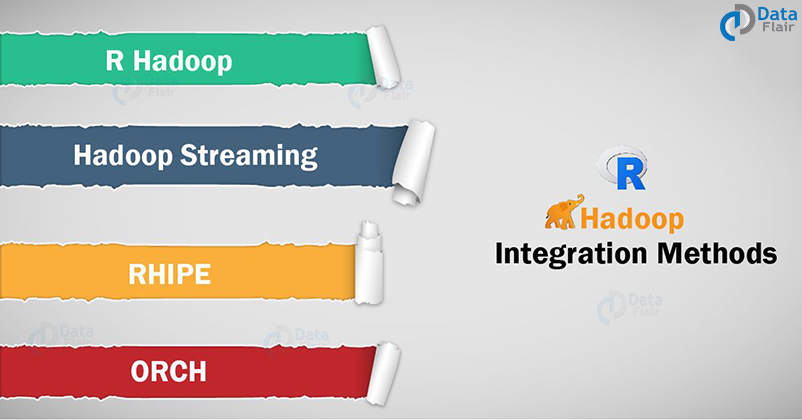R and Hadoop Integration – Enhance your skills with different methods!
FREE Online Courses: Click, Learn, Succeed, Start Now!
We will study about the R integration with Hadoop in this tutorial. We will provide you with different methods of R and Hadoop integration for Big Data analysis.
Without wasting any time, let’s start the tutorial.
Integration of R Programming with Hadoop
What is R Programming?
R is an open-source programming language. It is best suitable for statistical and graphical analysis. Also, if we are in need of strong data analytics and visualization features, then we need to combine R with Hadoop.
What is Hadoop?
Hadoop is an open-source tool that is founded by the ASF – Apache Software Foundation. It’s also an open-source project which means it is freely available and one can change its source code as per the requirements. Although, if certain functionality does not fulfill your needs, you can also alter it as per your needs. Moreover, it provides an efficient framework for running jobs.
Gain expertise in Hadoop technology with this awesome collection of 520+ Hadoop Tutorials
The purpose behind R and Hadoop Integration
R is one of the most preferred programming languages for statistical computing and data analysis. But without additional packages, it lacks a bit in terms of memory management and handling large data.
On the other hand, Hadoop is a powerful tool to process and analyze large amounts of data with its distributed file system HDFS and the map-reduce processing approach. At the same time, complex statistical calculations are as simple with Hadoop as they are with R.
By integrating these two technologies, R’s statistical computing power can be combined with efficient distributed computing. This means that we can:
- Use Hadoop to execute the R codes.
- Use R to access the data stored in Hadoop.
R and Hadoop Integration Methods
There are four types of methods for integrating R programming with Hadoop:
1. R Hadoop
The R Hadoop method is a collection of 3 packages. Here, we will discuss the functionalities of the three packages.
- The rmr package
- The rhbase package
- The rhdfs package
It’s the file management capabilities by integration with HDFS.
Don’t forget to check the Hadoop HDFS Tutorial
2. Hadoop Streaming
It’s R database management capability with integration with HBase. Hadoop streaming is the R Script available as part of the R package on CRAN. Also, this intends to make R more accessible to Hadoop streaming applications. Moreover, using this you can write MapReduce programs in a language other than Java.
It involves writing MapReduce codes in R language, which makes it extremely user-friendly. Java is the native language for MapReduce but according to today’s need, it doesn’t suit high-speed data analysis. Thus, in toady’s time, we need faster mapping and reducing steps with Hadoop.
Hadoop streaming has gained huge demand as we can write the codes in Python, Perl or even Ruby.
Time to learn the installation process of R Packages
3. RHIPE
RHIPE stands for R and Hadoop Integrated Programming Environment. Divide and Recombine developed this integrated programming environment for carrying out an efficient analysis of a large amount of data.
It involves working with R and Hadoop integrated programming environment. Also, one can use Python, Java or Perl to read data sets in RHIPE. There are various functions in RHIPE that lets you interact with HDFS. Hence, this way you can read, save the complete data that is created using RHIPE MapReduce.
4. ORCH
It is called Oracle R Connector. It can be used to particularly work with Big Data in Oracle appliance and also, on a non-Oracle framework like Hadoop.
ORCH helps in accessing the Hadoop cluster via R and also to write the mapping and reducing functions. Also, one can manipulate the data residing in the Hadoop Distributed File System.
You must definitely explore the Hadoop Cluster Tutorial
5. IBM’s BigR
IBM’s BigR provides end-to-end integration between IBM’s Hadoop package – BigInsights and R. BigR enables users to focus on the R program to analyze the data stored in the HDFS instead of MapReduce jobs. The combination of the BugInsights and the BigR technologies provides parallel execution of R code across the Hadoop cluster.
Summary
We have studied R and Hadoop integration in detail. We learned the different methods of integration of R programming with Hadoop.
Any queries or feedback? Share your views in the comment section below.
You give me 15 seconds I promise you best tutorials
Please share your happy experience on Google



can you provide more examples of R and Hadoop Integration.
what company use RHadoop?